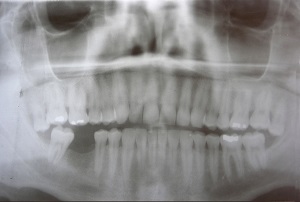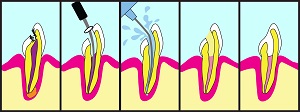
by Dr. Jacqueline S. Allen | Jan 27, 2016 | Blog, Endodontist, Phoenix Endodontic Group
 One of the most traumatic dental injuries a person can experience is having a permanent (“adult”) tooth knocked out. Many knocked-out teeth happen as a result of sports injuries or other accidental blows to the face. The good news is that if proper steps are followed immediately after the tooth is dislodged, it is possible for your Phoenix endodontist to help you save the tooth.
One of the most traumatic dental injuries a person can experience is having a permanent (“adult”) tooth knocked out. Many knocked-out teeth happen as a result of sports injuries or other accidental blows to the face. The good news is that if proper steps are followed immediately after the tooth is dislodged, it is possible for your Phoenix endodontist to help you save the tooth.
Saving Your Knocked-Out Tooth
- Pick up the tooth by the crown, not the root. It’s essential for the tooth’s survival that you pick up the tooth by the biting surface, not the root.
- Gently clean the tooth if it is dirty … but be careful how you do it. Gently clean the tooth with water. It’s important not to clean the tooth with soap or chemicals, to scrub the knocked-out tooth, or to wipe it with or wrap it in a cloth.
- Keep the tooth moist at all times. The best ways to keep the tooth moist after cleaning it are to keep it in milk, in the contents of an emergency tooth preservation kit such as Save-A-Tooth, or to place it back inside of your mouth.
- Reposition the tooth in its socket if that is possible. The sooner the tooth is replaced, the greater the likelihood it will survive. If you can get the tooth to sit in its socket, hold the tooth in place with fingers or by gently biting down on it.
- See your Phoenix endodontist immediately. Time is of the essence with a knocked-out tooth. The first hour is crucial. If you can get to a Phoenix endodontist within the first 20 minutes for emergency treatment, that’s even better.
Once you arrive at your Phoenix endodontist, he or she will splint the tooth in place and evaluate its condition. The splint may stay in place for up to several weeks. Because the tooth has been knocked out by its roots, he or she may recommend root canal treatment to avoid infection and provide long-term stability for the tooth.
“Don’t assume that if your tooth has been knocked out, it can’t be saved,” says Dr. Allen, who practices with the Phoenix Endodontic Group. “Your Phoenix endodontist can often save your tooth, and it can remain in your mouth for a lifetime.”

by Dr. Jacqueline S. Allen | Jan 21, 2016 | Blog, Endodontics, Root Canal
 Tooth pain can be exasperating. Its intensity can range from barely perceptible to agonizing, but it’s difficult for the layperson to know exactly what’s wrong. One thing that anyone experiencing tooth pain should NOT do is ignore it. Here are four common causes of tooth pain, all of which can often require a root canal to address and treat the source of the pain properly.
Tooth pain can be exasperating. Its intensity can range from barely perceptible to agonizing, but it’s difficult for the layperson to know exactly what’s wrong. One thing that anyone experiencing tooth pain should NOT do is ignore it. Here are four common causes of tooth pain, all of which can often require a root canal to address and treat the source of the pain properly.
4 Causes of Tooth Pain That Can’t Be Ignored
- Cavities – Tooth decay can cause holes in our teeth, which can make them sensitive and cause pain. Small cavities can be rectified with fillings, but if left untreated, they can cause serious infections that impact the roots of your teeth and require a root canal to fix.
- Chipped or cracked teeth – Even a tiny bit of damage to your tooth enamel can become a gateway for bacterial infection in your teeth. If the chip or crack leaves a jagged or sharp surface, the tooth can cause pain by lacerating your gums or tongue.
- Bruxism – Bruxism, or grinding one’s teeth, can cause serious pain from the act of clenching one’s jaw. The condition can also lead to cracked teeth, which can also let infection enter the tooth.
- Dental injuries – Any kind of violent impact to the face or mouth can cause pain and damage to the entire tooth, including its root.
Symptoms that may indicate a condition that may require a root canal to address them can include pain when pressure is applied to a tooth, pain that appears with hot or cold foods/drink and remains after the hot/cold stimulus is removed, a pimple-like bump on the gums, or a swelling of the gums near a tooth.
“Pain is our body’s early warning system, telling us something is wrong with our teeth,” says Dr. Jacqueline S. Allen, an endodontist who practices with the Phoenix Endodontic Group. “Root canals and other related treatments can provide prompt, lasting relief.”

by Dr. Jacqueline S. Allen | Dec 7, 2015 | Blog, Endodontics, Phoenix Endodontic Group, Root Canal
 When a full-blown toothache happens, it can seem almost impossible to ignore. But sometimes it can be unclear what is happening, or what to do next.
When a full-blown toothache happens, it can seem almost impossible to ignore. But sometimes it can be unclear what is happening, or what to do next.
An infection in your tooth root that has abscessed is a serious matter. Here are a few facts about abscessed teeth that can help you make the right decision for your health quickly and get the treatment, including a root canal, that you may need.
What happens when a tooth becomes abscessed
A tooth abscess happens when there is an infection in or around the root of the tooth. Infection can enter a tooth due to decay, a crack or a chip in the tooth, or when periodontal (gum) disease becomes advanced and the infection enters through a pocket (gap) between the tooth and the surrounding gums. When there is an abscess, the pulp inside of a tooth dies and may become inflamed.
Symptoms of a tooth abscess
Often patients with a tooth abscess will feel an ache in the bone around the tooth. This may start as a throbbing pain that won’t go away. Sensitivity in the tooth to heat and when chewing may also be present. Later, a fever may develop, or lymph nodes under the jaw or in the neck may swell and become tender. If the abscess breaks open, a sudden rush of foul-smelling and foul-tasting fluid (pus) may spill into the mouth.
After acute pain passes and the diseased pulpal tissue dies, the pain may fade, or even go away, but the problem won’t.
Treating an abscessed tooth
A dental specialist such as an endodontist should evaluate a tooth that may be abscessed. They will take a detailed history of the pain symptoms, test the responsiveness of the tooth to temperature and pressure, and evaluate radiographs (x-ray pictures) in order to help make a diagnosis.
It’s important to determine the origin of the infection. If the infection is inside the tooth’s pulp, a root canal treatment, with an appropriate restoration applied afterward, can ensure the infection doesn’t return. If it is a serious periodontal infection causing the abscess, the gums also will need to receive treatment to prevent the spread of the infection.
“Always take toothache symptoms seriously,” says Dr. Allen, an endodontist with the Phoenix Endodontic Group. “Get a professional evaluation. If it is being caused by an abscessed tooth, a root canal treatment can often save the tooth and keep it healthy for years to come.”

by Dr. Jacqueline S. Allen | Dec 2, 2015 | Blog, Dentistry, Endodontist, Patients
 It can take self-discipline to make appointments for regular dental care, but here’s a reason to be thankful you are able to make and pay for those checkups: surveys have indicated that 21 percent of Arizona adults and 31 percent of all Arizona children have never had a dental check-up. Even more concerning, more than 44 percent of Arizonans lack dental insurance, making care of critical dental needs financially challenging.
It can take self-discipline to make appointments for regular dental care, but here’s a reason to be thankful you are able to make and pay for those checkups: surveys have indicated that 21 percent of Arizona adults and 31 percent of all Arizona children have never had a dental check-up. Even more concerning, more than 44 percent of Arizonans lack dental insurance, making care of critical dental needs financially challenging.
To rectify this situation, the Central Arizona Dental Society Foundation is hosting its annual Arizona Dental Mission of Mercy (AZMOM) event on Dec. 11 and 12 at the Arizona State Fairgrounds, 1826 W. McDowell Road, Phoenix. AZMOM is a dental clinic that offers basic dental care at no cost to the individuals being treated.
More than 2,000 patients are seen each year at the AZMOM event, and care is provided at the dental clinic by nearly 1,500 volunteers, including clinicians such as dentists, dental hygienists and dental assistants, as well as hundreds of non-clinical volunteers who help make the event run smoothly. In 2014, $1.8 million in free dental care was provided.
Because it is a dental clinic in a temporary location set up for a short duration, AZMOM focuses on providing basic care and relieving pain and infection. Patients are seen on a first-come, first-served basis. Providers treat patients by performing extractions, filling cavities and performing prophylactic dental cleanings.
Those wanting to participate in the AZMOM event will want to arrive well before the clinic doors open at 6 a.m. each day. Once the total numbers of patients that can seen each day have been registered, no additional patients can be accommodated. Patients seeking treatment at the dental clinic should be prepared to spend the entire day at the event.
Dr. Jacqueline S. Allen, who practices with the Phoenix Endodontics Group, said the AZMOM event was a way for dental professionals in Arizona to give back to the community and improve the state’s overall oral health situation. “The free AZMOM dental clinic allows dentists to provide critical care to those who need it the most, and can afford it the least,” she said. “Please spread the word to anyone who could benefit from this event.”
More information on the AZMOM event is available online at the AZMOM website.

by Dr. Jacqueline S. Allen | Nov 30, 2015 | Blog, Endodontics, Root Canal
 Having a clear idea about what a root canal entails is the first step toward knowing whether it is the right treatment for your dental challenges. Dr. Jacqueline S. Allen of the Phoenix Endodontic Group says, “It’s important for patients to understand the root canal process. Having full comprehension of what’s really involved in this procedure can make it easier for them to make truly informed decisions about their oral health.”
Having a clear idea about what a root canal entails is the first step toward knowing whether it is the right treatment for your dental challenges. Dr. Jacqueline S. Allen of the Phoenix Endodontic Group says, “It’s important for patients to understand the root canal process. Having full comprehension of what’s really involved in this procedure can make it easier for them to make truly informed decisions about their oral health.”
The Root Canal Process
- A patient presenting with symptoms of pain, tooth discoloration, prolonged sensitivity to heat or cold, or tenderness to the touch or when chewing is referred to an endodontist for diagnosis.
- The endodontist will examine the tooth and take X-rays to determine if the pulp of the tooth is infected and/or inflamed. If so, an appointment to perform a root canal treatment will be set up.
- On the day of the root canal treatment, the endodontist may numb the treatment area with a local anesthetic and place a dental dam around the affected tooth to keep it free of saliva and debris.
- Next, the dentist will access the root canals of the tooth through its crown, and use special metal files to clean the canals and remove the infected pulp from the tooth.
- After the pulp is removed, the endodontist will fill the canals with a bio-compatible material known as gutta-percha. A temporary filling will be placed in the tooth opening to seal off the canals.
- When the patient returns to the endodontist, the temporary filling will be removed, to make way for a crown or other permanent restoration to be placed by a restorative dentist. If the tooth lacks structure to hold the restoration in place, the endodontist or restorative dentist may place a post in the tooth.
Re-treatment of the tooth with the root canal may be needed later if it becomes injured or suffers additional tooth decay. In both cases, the sealed canals could be exposed to additional infection or inflammation.
“The root canal process is fairly straightforward, and has a success rate of about 90 percent,” Dr. Allen says. “Clarity about what to expect can help patients who need this procedure feel more confident that they are making an excellent choice for their health.”
by Dr. Jacqueline S. Allen | Nov 9, 2015 | Blog, Endodontist
Our teeth are sturdy and resilient enough to last a lifetime. However, sometimes we can experience a dental condition that will put the health of a natural tooth at risk. It can be tricky to know exactly when to see a Phoenix endodontist, when to see your general dentist, and when to take a “wait and see” approach to a tooth challenge. Here are several situations in which you should definitely consider making an appointment to see your Phoenix endodontist to make sure your natural tooth will survive and thrive.
It may be time to see a Phoenix endodontist when …
- You have serious tooth decay that’s led to a bacterial infection. Bacterial plaque forms on our teeth almost immediately after we eat. It can wear down the tooth’s enamel, and eventually tooth decay can erode much of the tooth’s structure. Oral bacteria are the most common cause of endodontic problems, and infection in your natural teeth can lead to an abcess if not properly cared for.
- You have a chip or crack in your natural tooth. Tooth decay can gradually wear down your tooth’s structure; damage from a chip or crack can create that structural damage in an instant. These sorts of dental injuries can expose the vulnerable tooth pulp to infection, leading to the need for a root canal treatment.
- You’ve experienced a dental injury. If you experienced a blow to your mouth or face, you may need to be seen by a Phoenix endodontist to evaluate a chipped or cracked tooth, or even a tooth that has partially or completely dislodged itself from your jaw. Even if the tooth or teeth that absorbed most of the impact seems fine, it’s a good idea to make an appointment with your endodontist; sometimes teeth adjacent to the injury site can be affected, as well.
It’s important to note that an adult natural tooth can survive with out its inner pulp (which is why root canal treatments are often so successful), but it is not always able to remain in one’s jaw if the structural damage caused by an infection or injury is too great. “Your Phoenix endodontist will evaluate your tooth carefully when you’re experiencing discomfort or concern, and provide specialized treatments, if needed, to conserve your natural tooth,” says Dr. Allen, who practices with the Phoenix Endodontic Group.

 One of the most traumatic dental injuries a person can experience is having a permanent (“adult”) tooth knocked out. Many knocked-out teeth happen as a result of sports injuries or other accidental blows to the face. The good news is that if proper steps are followed immediately after the tooth is dislodged, it is possible for your Phoenix endodontist to help you save the tooth.
One of the most traumatic dental injuries a person can experience is having a permanent (“adult”) tooth knocked out. Many knocked-out teeth happen as a result of sports injuries or other accidental blows to the face. The good news is that if proper steps are followed immediately after the tooth is dislodged, it is possible for your Phoenix endodontist to help you save the tooth.

 Tooth pain can be exasperating. Its intensity can range from barely perceptible to agonizing, but it’s difficult for the layperson to know exactly what’s wrong. One thing that anyone experiencing tooth pain should NOT do is ignore it. Here are four common causes of tooth pain, all of which can often require a root canal to address and treat the source of the pain properly.
Tooth pain can be exasperating. Its intensity can range from barely perceptible to agonizing, but it’s difficult for the layperson to know exactly what’s wrong. One thing that anyone experiencing tooth pain should NOT do is ignore it. Here are four common causes of tooth pain, all of which can often require a root canal to address and treat the source of the pain properly.




